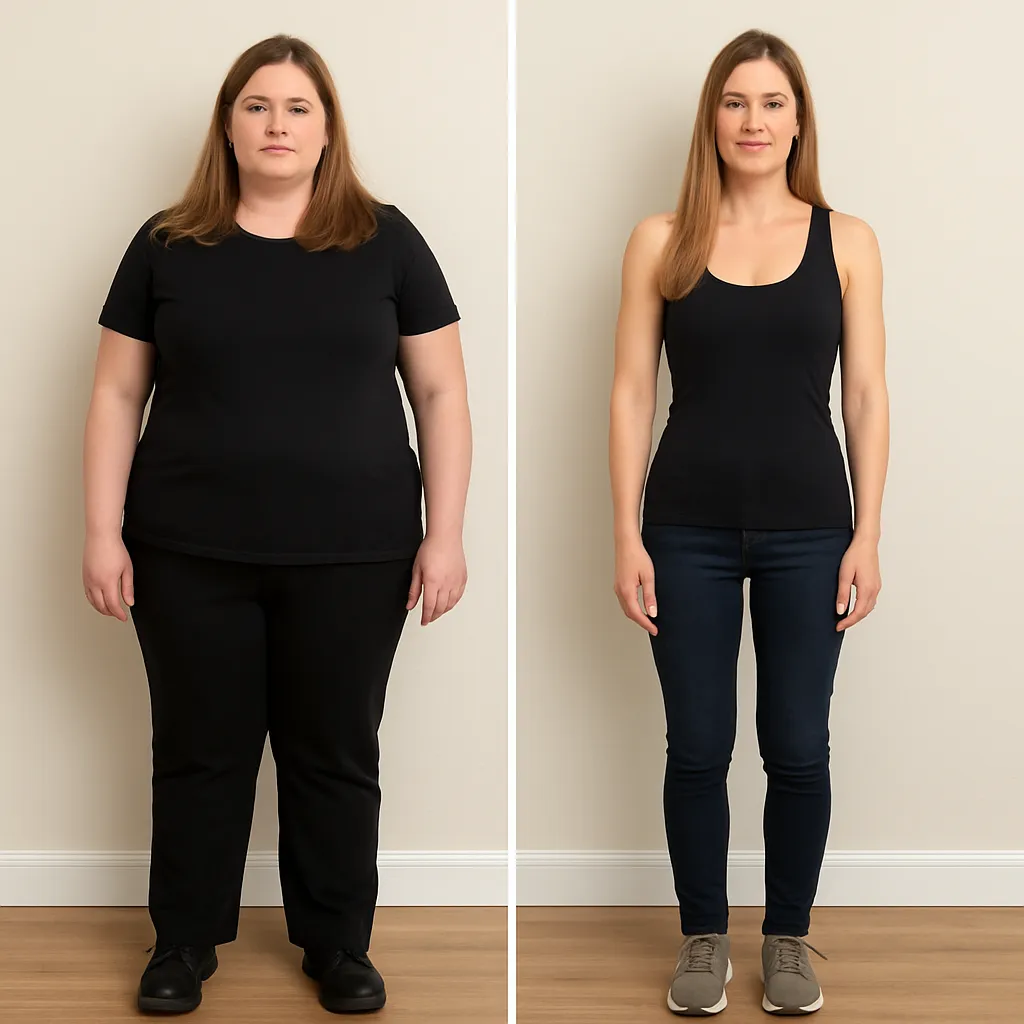
From Size 20 to 12: How Long It Really Takes and What It Actually Requires
"From Size 20 to 12: How Long It Really Takes and What It Actually Requires"- Misty Creaghe
Let’s have a heart-to-heart, woman to woman.
We’ve all seen those jaw-dropping before-and-after photos. “I went from a size 20 to a size 12 in 90 days doing this indoor walking challenge!” And while it makes you stop scrolling, it also makes you wonder — is that even possible?
Let’s cut through the hype and get honest about what it takes to drop from a size 20 to a size 12. In this blog, I’ll break down what that transformation realistically looks like with different approaches, how long each method takes, and why some work better than others. I’ll give you the good, the bad, and the ugly — so you can build a plan that actually works for your life, not your social media feed.
How Much Fat Loss Does a Size 20 to a Size 12 Drop Require?
Before we dive into the methods, let’s get clear on what this kind of transformation requires. On average, going from a size 20 to a size 12 involves losing 50–70 pounds, depending on your height, muscle mass, and how clothing brands cut their sizes.
Safe and sustainable fat loss is 0.5–2 pounds per week. That means — at best — you’re looking at 6 months to 1.5 years for this transformation if done the healthy way.
Method-by-Method Breakdown: What Happens If You Try It This Way?
Let’s walk through what it looks like if you try to drop from a size 20 to a 12 using different strategies.
1️⃣ Cardio-Only Approach
Calories burned per session: 200–400
Time estimates for 50–70 lbs. loss: 2–3 years
Pros: Easy to start, improves heart health
Cons: Muscle loss, slowed metabolism, higher cortisol, frequent plateaus
You’ll likely lose weight early on, but without strength training or nutrition support, you risk becoming a smaller, weaker, exhausted version of yourself. This method is rarely sustainable for dramatic transformation alone.
2️⃣ Calorie Cut-Only (No Exercise)
Calorie deficit: 500–1,000 per day
Potential weight loss: 1-2 lbs. per week
Time estimate: 8 months–1.5 years
Pros: Quick initial weight loss
Cons: Rapid muscle loss, energy crashes, slowed metabolism, higher regain risk
This route typically leads to faster scale changes but leaves you “skinny fat” (smaller, weaker, still as giggly version of yourself) and metabolically fragile.
3️⃣ Cardio + Calorie Deficit
Faster initial fat loss
Time estimate: 6–12 months
Pros: Boosts calories burn
Cons: Increased hunger, possible burnout, risk of overtraining and cravings, energy dips, possible hormonal imbalances
Most traditional diet plans fall here — they work for a while but usually plateau without muscle-building exercise. It also doesn't preserve your muscle as well.
4️⃣ Strength Training Alone
Time estimate: 2–3 years
Pros: Builds muscle, boosts metabolism long-term, tones body, improves posture and energy.
Cons: Fat loss is slower without calorie control
You’ll notice your clothes fit better even if the scale doesn’t move much, but size 20 to 12 would take a long time without dialing in nutrition.
5️⃣ Strength Training + Basic Nutrition (Calorie Control)
Time estimate: 9–18 months
Pros: Faster fat loss, preserves muscle, better energy, Tighter toned look
Cons: Can plateau if stress, sleep, and NEAT aren’t addressed due to their influence on cravings, recovery, and fat storage
This is a solid, reliable path — but there’s still room to make results come easier.
6️⃣ Strength Training + Metabolism-Boosting Nutrition
Includes: Adequate protein, smart carbs, healthy fats, nutrient-dense food
Time estimate: 6–12 months
Pros: Higher energy, better recovery, fewer cravings, metabolism heals
Cons: Requires consistency and strategy
This approach shortens the learning curve because it fuels your metabolism instead of starving it.
7️⃣ Strength Training + Nutrition + Stress Management
Adds: Cortisol-lowering tools like breathwork, boundaries, nervous system resets
Time estimate: 5–10 months
Pros: Fewer stress-eating episodes, better sleep, smoother fat loss improved mood
Cons: Takes habit work and lifestyle changes
Without this, you risk emotional eating and burnout undoing your hard work.
8️⃣ The Complete Approach: Strength Training + NEAT + Nutrition + Stress Management + Sleep Optimization + Mindset Work
Time estimate: 4–8 months
Pros: Faster, sustainable fat loss, muscle tone, better energy, better sleep, mood balance, confidence and joy returning, minimal rebound, reduced cravings, Improves mental health,
Cons: Requires commitment and patience
This is the system high-achievers and sustainable weight-loss success stories follow — whether they realize it or not. It cuts through the guesswork and creates real, lasting change.
How Each Added Layer Shortens the Learning Curve

The Good, The Bad, and The Ugly
The Good: You absolutely can go from a size 20 to a size 12. The key is stacking habits that work together instead of chasing one quick fix.
The Bad: It won’t happen overnight. Cardio-only and crash diets aren’t the answer, and chasing fast results usually backfires.
The Ugly: If you don’t address metabolism, stress, sleep, and mindset, you risk burning out, hitting plateaus, or regaining weight.
But here’s the truth: The freedom lies in choosing the sustainable path. The one that lets you lose the weight and keep it off — while feeling like your best self, not a drained version of yourself.

If your done with quick fixes — good. That means you’re ready.
I built my Ultimate Burnout Breakthrough Blueprint to help women ready to make a plan that works for your real life I'll help you map out exactly what your personalized fat loss roadmap, your stress load, your schedule, and your goals. This blueprint is for career women, moms, and caretakers who’ve lost themselves in the hustle and want their energy, confidence, and life back.
👉 Click here to book a free Burnout Breakthrough Session and let’s uncover your path together.
No fluff. No pressure. Just real, honest coaching.
Your future self is waiting.
Misty 💛
1 Away Fitness | Your Burnout Breakthrough Guide
